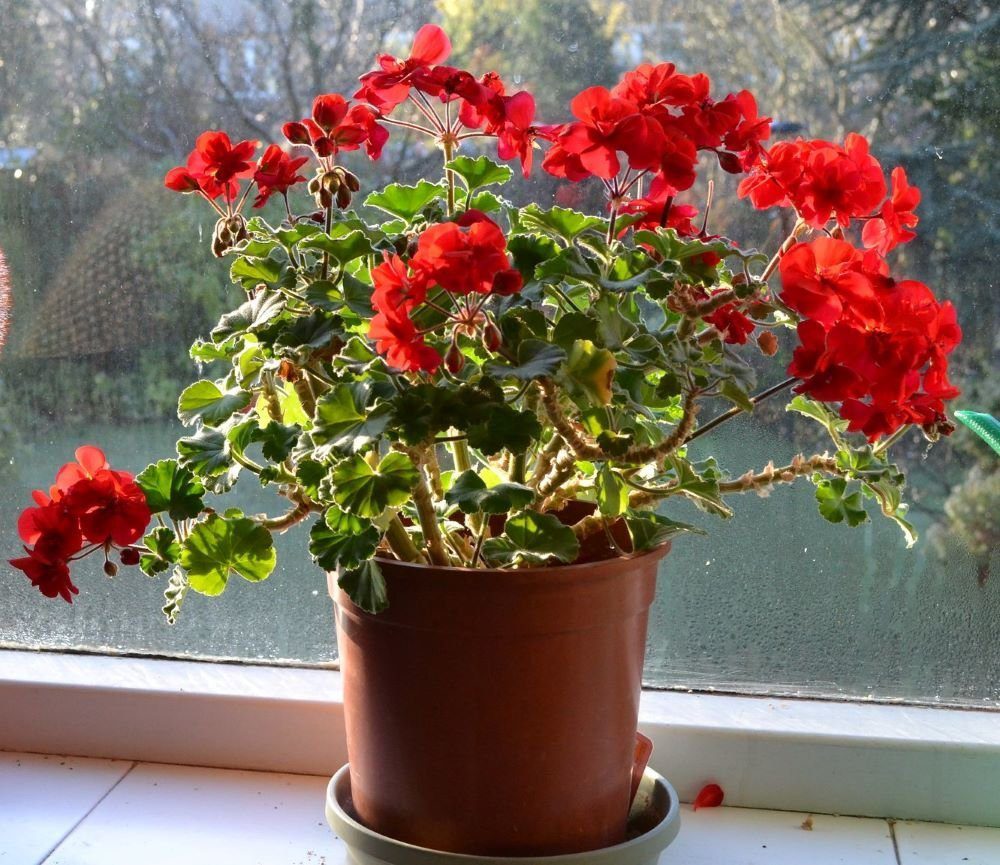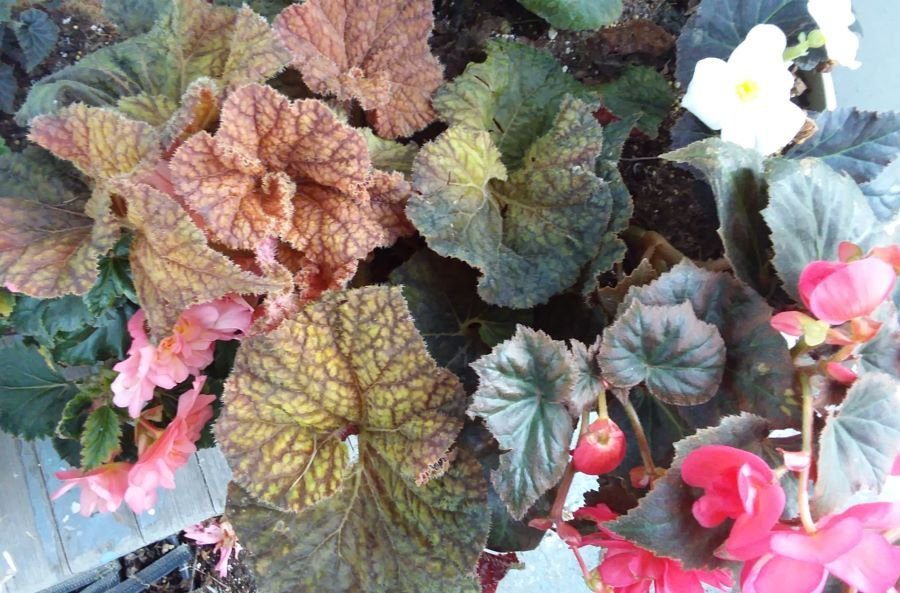Plants That Can Move Indoors When It Gets Cold

We all love our gardens and the flowers we’ve cared for. What most people don’t realize is that you can move many indoors.
First let’s deal with plants that can bloom, or at least live, indoors for the winter. In many cases they are tropical, perennial plants that would bloom year around outdoors if you lived in a warm climate like Florida. But since many people live in colder climates, here are some suggestions.
1. Geraniums

Maybe you have finally found a red-colored geranium you really love, like the Super Moon, above. Or, like me, you paid $45 for a giant pot of geraniums that are still blooming, and can’t see throwing them away. Or, like me, you are cheap, don’t want to replace everything and know how to get geraniums to avoid dormancy, and have a sunny window. And room.
Since we’re not dealing here with taking cuttings, or storing dormant plants, just with bringing those geraniums indoors, you had better make haste. First you should stop watering, and do serious pruning. Off with their (flower) heads. You want to prune those geraniums two-thirds back.
True, what is left is not a gorgeous houseplant. But geraniums do not bloom on woody stems. You have to encourage new growth. Repot them if they are root bound (they are probably not). Introduce watering sparingly. Be aware that humidity indoors is much less than outdoors, and occasionally mist the area near your houseplants. Or put your humidifier in that part of the room. The geraniums will bounce back and begin blooming in a few months.
Then again, maybe it’s too late, and they have already gone into dormancy. In that case, put them in a dark place, do not water, and hope they will regrow in the spring.
2. Ferns

Those hanging baskets on porches that alternate geraniums and ferns. The plant stands, ditto. Boston ferns love life on a porch, but they also will live happily indoors. The secret is in the transfer. Again with the cutting back. Some experts suggest cutting all of the fronds that hang down. That seems extreme. Of course remove dead fronds, brown and broken fronds, and the fronds that seem to be “underneath” the rest,” where they won’t get much light indoors. The growing part of the fern are those fronds right at the center.
Next, introduce it gradually to its new home. Don’t water it, and move it just inside the door, where it’s still pretty cold, gets blasts of outside air and is away from any radiators or heat vents. It can live there for a week or two, unless outside temperatures are well below freezing.
When you find the right home for it – filtered light in a bright, sunny room – remember to turn it every two weeks, and water it once a week. Do not think about fertilizing it. Your fern is having a nice winter nap. It won’t turn brown, but it’s not going to grow into the beautiful, lush fern it was outdoors.
Still, it will be pretty. Oh, one more thing. It likes the room to be about 50 to 55 degrees. So you’re not going to spend much time in that bright, sunny, cold room looking at it. Sounds like a sun porch with mini-blinds partly closed to me. Or your very parsimonious auntie’s parlor, where the heat is never turned on.
3. Begonias

Sometimes the colors of a particular tuberous begonia are so enchanting you don’t want to lose it. These begonias grow from a tuber, duh, thus the name. They are showy, and almost impossible to overwinter as a house plant. You can, however, bring the pot indoors, let the leaves die down, do not water the tuber, and simply set it out again in the spring. Experts talk about digging up the corm (or tuber) and drying it and storing it, then replanting it. But why? It will dry out in the pot just fine. Of course if you have planted the tuberous begonias in the ground you do have to dig them up.
You can also keep these begonias limping along with a few green leaves, as I do. Give them very little water. Treat them as invalids. Think of them as “mostly dead.” Then set them outdoors in the spring in the same pot. Water them consistently, which for begonias means “not too much.” That gorgeous tuberous begonia will bloom again.
The wax begonias. Forget them.

But the rhizomatous begonias! I bought a rhizomatous begonia at the Tradewinds plant fair in Connecticut in May, not knowing what I was getting into. It had a couple of leaves with funny patterns, and was $4. He said it would not have very interesting flowers, if any. I didn’t know it was called a Rex begonia. I didn’t know it was supposed to be hard to grow. I stuck it into the same pot with my back-from-the-dead tuberous begonias on my north porch, where late afternoon sun peeks around in June, and most of the watering is done by wind and rain. That Rex begonia, above, has grown into a lovely, furry monster.
Only now do I find out they are supposed to be hard to grow, and I was supposed to be fertilizing it, and misting it, treating it like a baby and hoping it would grow. And now I’m sorry I didn’t buy a clipping of the Rex begonia called “escargot,” where the leaf patterns wind around in a circle.
Rhizomatous begonias can be indoor plants, so Rex is coming indoors. It is supposed to bloom in late winter. My main worry is that, now it that will be indoors, it will require all of that babying. I, on the other hand, am good at benign neglect.
I suppose I could leave it and its fellow begonias downstairs, in a cold, drafty hallway about five feet from the porch, and water them only once in a while. I’m still thinking.
The point is that you have to know your begonias. Big flowers, that’s a tuberous begonia. Unless you are devoted to it, let it die, and maybe hope it comes back next spring. Rhizomatous begonia (no flowers to speak of) but gorgeous patterns on the leaves, those go indoors. They might even stay indoors, unless you have an ideal place for them back outside. Wax begonias, cheap bedding plants.
4. Gerbera Daisies

I always buy a few gerbera daisies for my side garden, because they bloom reliably all summer as long as I deadhead. This year I thought, “Why not bring them indoors?” In fact, gerbera make great house plants. They, like most of the other plants I discuss here, are tropical, in this case, from South Africa.
My gerberas are in the ground, so that means potting them up. I’m going to cut them back and give them a little rest. But I want to reserve enough leaves to nourish the plant in my East/South windows. I’m on the second floor, so no matter how low the sun is in the sky, I get good sun all day.
I have a second set of six south-facing windows, for the over-flow plants.
5. Salvia, Corn Plants and Other Oddments

You are going to think I’m crazy here, but you have not met Salvia splendens Vista Purple. I found it late in the season at Ward’s nursery in Great Barrington, Massachusetts. It was on sale, but still expensive. It did not occur to me until I got it home that it was an annual salvia, not a perennial. This baby grows in Brazil. Or, if you prefer, in zones 9-10. Again, I live in 5b. So something needs to be done. I am going to remove it from the wrought iron planter, where it is the centerpiece, pot it, and then try to figure out what it wants. It likes full sun and well-drained soil, lots of heat and dead-heading.
That means cutting back, upstairs in a starring position at the apex of exposure to sun, right above the radiators, with some help from the humidifier. Not too much watering. And careful tending once it begins to flower. The butterflies and hummingbirds loved it outdoors. I can’t imitate that indoors.
I am determined to turn Vista Purple into a perennial, at least for next season.
And then there is my corn plant. This is no beauty. It will not stand up to close inspection. But it comes with history.

My son had a corn plant for 10 years called the Colonel. (Corn… Colonel?) Then he left it outside too late in the year. Dead.
But I told him, “You can’t kill these things.” We dumped out the dirt and I pulled up the roots. We sawed them in two. He took half and I took half. (Did I mention that my son is an adult?)
Four years later my corn plant is two trunks, about six feet tall, glossy and healthy. Well, it could use some weeding.
It lives on the outdoor porch, in partial sun, from May to October. I move it about 10 feet, inside, near a west-facing window, in winter. Next summer I’ll repot it. Not because it needs it but because it’s so tall the wind keeps blowing it over. It just needs a bigger tub, a heavier anchor. We will not mention what happened with my son’s plant.
You may have your own odd-ball plant, something you bought that you want to keep going. There is no reason to let it die. Find a room, find a window. Buy a grow light if necessary. Turn off a radiator. If you have to, a put on a sweater.
It’s what we do for our gardens. A lot of work, but we love what we work for, and we work for what we love.
Linda Lee
Linda Lee was an editor at the New York Times. She was the deputy editor of the House & Home section, where she edited the garden column, among other duties. And she wrote frequently for Sunday Styles.
Photo credit featured image of geranium on the window sill: Nina Childish
